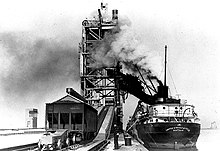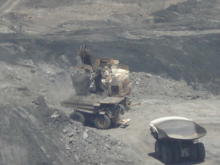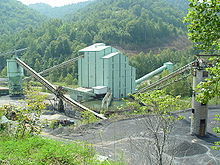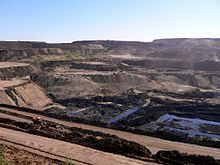
A | B | C | D | E | F | G | H | CH | I | J | K | L | M | N | O | P | Q | R | S | T | U | V | W | X | Y | Z | 0 | 1 | 2 | 3 | 4 | 5 | 6 | 7 | 8 | 9




Coal mining is the process of extracting coal from the ground or from a mine. Coal is valued for its energy content and since the 1880s has been widely used to generate electricity. Steel and cement industries use coal as a fuel for extraction of iron from iron ore and for cement production. In the United Kingdom and South Africa, a coal mine and its structures are a colliery, a coal mine is called a "pit", and above-ground mining structures are referred to as a "pit head". In Australia, "colliery" generally refers to an underground coal mine.
Coal mining has had many developments in recent years, from the early days of men tunneling, digging, and manually extracting the coal on carts to large open-cut and longwall mines. Mining at this scale requires the use of draglines, trucks, conveyors, hydraulic jacks, and shearers.
The coal mining industry has a long history of significant negative environmental impacts on local ecosystems, health impacts on local communities and workers, and contributes heavily to the global environmental crises, such as poor air quality and climate change. For these reasons, coal has been one of the first fossil fuels to be phased out of various parts of the global energy economy. The major coal producing countries, though, such as China, Indonesia, India and Australia, have not reached peak production, with production increases replacing falls in Europe and U.S.[1] and proposed mines under development.[2]
History
The history of coal mining goes back thousands of years, with early mines documented in ancient China, the Roman Empire and other early historical economies. It became important in the Industrial Revolution of the 19th and 20th centuries, when it was primarily used to power steam engines, heat buildings and generate electricity. Coal mining continues as an important economic activity today, but has begun to decline due to the strong contribution coal plays in global warming and environmental issues, which result in decreasing demand and in some geographies, peak coal.
Compared to wood fuels, coal yields a higher amount of energy per unit mass, specific energy or massic energy, and can often be obtained in areas where wood is not readily available. Though it was used historically as a domestic fuel, coal is now used mostly in industry, especially in smelting and alloy production, as well as electricity generation. Large-scale coal mining developed during the Industrial Revolution, and coal provided the main source of primary energy for industry and transportation in industrial areas from the 18th century to the 1950s. Coal remains an important energy source.[3] Coal is also mined today on a large scale by open pit methods wherever the coal strata strike the surface or are relatively shallow. Britain developed the main techniques of underground coal mining from the late 18th century onward, with further progress being driven by 19th-century and early 20th-century progress.[3] However, oil and gas were increasingly used as alternatives from the 1860s onward.
By the late 20th century, coal was, for the most part, replaced in domestic as well as industrial and transportation usage by oil, natural gas or electricity produced from oil, gas, nuclear power or renewable energy sources. By 2010, coal produced over a fourth of the world's energy.[4]
Since 1890, coal mining has also been a political and social issue. Coal miners' labour and trade unions became powerful in many countries in the 20th century, and often, the miners were leaders of the Left or Socialist movements (as in Britain, Germany, Poland, Japan, Chile, Canada and the U.S.)[5][6] Since 1970, environmental issues have been increasingly important, including the health of miners, destruction of the landscape from strip mines and mountaintop removal, air pollution, and coal combustion's contribution to global warming.
| Part of a series on |
| Coal |
|---|
 |
Methods of extraction
Coal extraction methods vary depending on whether the mine is an underground mine or a surface (also called an open cast) mine. Additionally, coal seam thickness and geology are factors in the selection of a mining method. The most economical method of coal extraction for surface mines is the electric shovel or drag line. The most economical form of underground mining is the long wall, which involves using two spinning drums with carbide bits that runs along sections of the coal seam. Many coals extracted from both surface and underground mines require washing in a coal preparation plant. Technical and economic feasibility are evaluated based on the following: regional geological conditions; overburden characteristics; coal seam continuity, thickness, structure, quality, and depth; strength of materials above and below the seam for roof and floor conditions; topography, especially altitude and slope; climate; land ownership as it affects the availability of land for mining and access; surface drainage patterns; groundwater conditions; availability of labor and materials; coal purchaser requirements in terms of tonnage, quality, and destination; and capital investment requirements.[7]
Surface mining and deep underground mining are the two basic methods of mining. The choice of mining method depends primarily on depth, density, overburden, and thickness of the coal seam; seams relatively close to the surface, at depths less than approximately 55 m (180 ft), are usually surface mined.[citation needed]
Coal that occurs at depths of 55 to 90 m (180 to 300 ft) are usually deep mined, but in some cases surface mining techniques can be used. For example, some western U.S. coal that occur at depths in excess of 60 m (200 ft) are mined by the open pit methods, due to thickness of the seam 20–25 metres (60–90 feet). Coals occurring below 90 m (300 ft) are usually deep mined.[8] However, there are open pit mining operations working on coal seams up to 300–460 metres (1,000–1,500 feet) below ground level, for instance Tagebau Hambach in Germany.
Surface mining

When coal seams are near the surface, it may be economical to extract the coal using open-cut, also referred to as open-cast, open-pit, mountaintop removal or strip, mining methods. Opencast coal mining recovers a greater proportion of the coal deposit than underground methods, as more of the coal seams in the strata may be exploited. This equipment can include the following: Draglines which operate by removing the overburden, power shovels, large trucks in which transport overburden and coal, bucket wheel excavators, and conveyors. In this mining method, explosives are first used in order to break through the surface or overburden, of the mining area. The overburden is then removed by draglines or by shovel and truck. Once the coal seam is exposed, it is drilled, fractured and thoroughly mined in strips. The coal is then loaded onto large trucks or conveyors for transport to either the coal preparation plant or directly to where it will be used.[9]
Most open cast mines in the United States extract bituminous coal. In Canada, Australia, and South Africa, open cast mining is used for both thermal and metallurgical coals. In New South Wales open casting for steam coal and anthracite is practiced. Surface mining accounts for around 80 percent of production in Australia, while in the US it is used for about 67 percent of production. Globally, about 40 percent of coal production involves surface mining.[9]
Strip mining
Strip mining exposes coal by removing earth above each coal seam. This earth to be removed is referred to as 'overburden' and is removed in long strips.[10] The overburden from the first strip is deposited in an area outside the planned mining area and referred to as out-of-pit dumping. Overburden from subsequent strips is deposited in the void left from mining the coal and overburden from the previous strip. This is referred to as in-pit dumping.[citation needed]
It is often necessary to fragment the overburden by use of explosives. This is accomplished by drilling holes into the overburden, filling the holes with explosives, and detonating the explosive. The overburden is then removed, using large earth-moving equipment, such as draglines, shovel and trucks, excavator and trucks, or bucket-wheels and conveyors. This overburden is put into the previously mined (and now empty) strip. When all the overburden is removed, the underlying coal seam will be exposed (a 'block' of coal). This block of coal may be drilled and blasted (if hard) or otherwise loaded onto trucks or conveyors for transport to the coal preparation (or wash) plant. Once this strip is empty of coal, the process is repeated with a new strip being created next to it. This method is most suitable for areas with flat terrain.[citation needed]
Equipment to be used depends on geological conditions. For example, to remove overburden that is loose or unconsolidated, a bucket wheel excavator might be the most productive. The life of some area mines may be more than 50 years.[11]
Contour mining
The contour mining method consists of removing overburden from the seam in a pattern following the contours along a ridge or around the hillside. This method is most commonly used in areas with rolling to steep terrain. It was once common to deposit the spoil on the downslope side of the bench thus created, but this method of spoil disposal consumed much additional land and created severe landslide and erosion problems. To alleviate these problems, a variety of methods were devised to use freshly cut overburden to refill mined-out areas. These haul-back or lateral movement methods generally consist of an initial cut with the spoil deposited downslope or at some other site and spoil from the second cut refilling the first. A ridge of undisturbed natural material 15 to 20 ft (5 to 6 m) wide is often intentionally left at the outer edge of the mined area. This barrier adds stability to the reclaimed slope by preventing spoil from slumping or sliding downhill.[citation needed]
The limitations of contour strip mining are both economic and technical. When the operation reaches a predetermined stripping ratio (tons of overburden/tons of coal), it is not profitable to continue. Depending on the equipment available, it may not be technically feasible to exceed a certain height of highwall. At this point, it is possible to produce more coal with the augering method in which spiral drills bore tunnels into a highwall laterally from the bench to extract coal without removing the overburden.[citation needed]
Mountaintop removal mining
Mountaintop coal mining is a surface mining practice involving removal of mountaintops to expose coal seams, and disposing of associated mining overburden in adjacent "valley fills." Valley fills occur in steep terrain where there are limited disposal alternatives.[12]
Mountaintop removal mining combines area and contour strip mining methods. In areas with rolling or steep terrain with a coal seam occurring near the top of a ridge or hill, the entire top is removed in a series of parallel cuts. Overburden is deposited in nearby valleys and hollows. This method usually leaves the ridge and hilltops as flattened plateaus.[8] The process is highly controversial for the drastic changes in topography, the practice of creating head-of-hollow-fills, or filling in valleys with mining debris, and for covering streams and disrupting ecosystems.[13][14]
Spoil is placed at the head of a narrow, steep-sided valley or hollow. In preparation for filling this area, vegetation and soil are removed and a rock drain constructed down the middle of the area to be filled, where a natural drainage course previously existed. When the fill is completed, this underdrain will form a continuous water runoff system from the upper end of the valley to the lower end of the fill. Typical head-of-hollow fills are graded and terraced to create permanently stable slopes.[11]
Underground mining


Most coal seams are too deep underground for opencast mining and require underground mining, a method that currently accounts for about 60 percent of world coal production.[9] In deep mining, the room and pillar or bord and pillar method progresses along the seam, while pillars and timber are left standing to support the mine roof. Once room and pillar mines have been developed to a stopping point limited by geology, ventilation, or economics, a supplementary version of room and pillar mining, termed second mining or retreat mining, is commonly started. Miners remove the coal in the pillars, thereby recovering as much coal from the coal seam as possible. A work area involved in pillar extraction is called a pillar section.[15]
Modern pillar sections use remote-controlled equipment, including large hydraulic mobile roof-supports, which can prevent cave-ins until the miners and their equipment have left a work area. The mobile roof supports are similar to a large dining-room table, but with hydraulic jacks for legs. After the large pillars of coal have been mined away, the mobile roof support's legs shorten and it is withdrawn to a safe area. The mine roof typically collapses once the mobile roof supports leave an area.[citation needed]
There are six principal methods of underground mining:
- Longwall mining accounts for about 50 percent of underground production. The longwall shearer has a face of 1,000 feet (300 m) or more. It is a sophisticated machine with a rotating drum that moves mechanically back and forth across a wide coal seam. The loosened coal falls onto an armored chain conveyor or pan line that takes the coal to the conveyor belt for removal from the work area. Longwall systems have their own hydraulic roof supports which advance with the machine as mining progresses. As the longwall mining equipment moves forward, overlying rock that is no longer supported by coal is allowed to fall behind the operation in a controlled manner. The supports make possible high levels of production and safety. Sensors detect how much coal remains in the seam while robotic controls enhance efficiency. Longwall systems allow a 60-to-100 percent coal recovery rate when surrounding geology allows their use. Once the coal is removed, usually 75 percent of the section, the roof is allowed to collapse in a safe manner.[9]
- Continuous mining utilizes a continuous miner machine with a large rotating steel drum equipped with tungsten carbide picks that scrape coal from the seam. Operating in a "room and pillar", also known as "bord and pillar" system, where the mine is divided into a series of 20-to-30-foot (5–10 m) "rooms" or work areas cut into the coalbed—it can mine as much as 14 tons of coal a minute, more than a non-mechanised mine of the 1920s would produce in an entire day. Continuous miners account for about 45 percent of underground coal production. Conveyors transport the removed coal from the seam. Remote-controlled continuous miners are used to work in a variety of difficult seams and conditions, and robotic versions controlled by computers are becoming increasingly common. Continuous mining is a misnomer, as room and pillar coal mining is very cyclical. In the US, one can generally cut up to around 20 feet (6 meters). This may be increased with MSHA permission. In South Africa, the limit may be as high as 12 metres (39 ft). After the cutting limit is reached, the continuous miner assembly is removed and the roof is supported by the use of a roof bolter, after which the face has to be serviced before it can be advanced again. During servicing, the "continuous" miner moves to another face. Some continuous miners can bolt and rock dust the face, two major components of servicing, while cutting coal, while a trained crew may be able to advance ventilation, to truly earn the "continuous" label. However, very few mines are able to achieve it. Most continuous mining machines in use in the US lack the ability to bolt and dust. This may partly be because the incorporation of bolting makes the machines wider, and therefore, less maneuverable.[16]
- Room and pillar mining consists of coal deposits that are mined by cutting a network of rooms into the coal seam. Pillars of coal are left behind in order to keep up the roof. The pillars can make up to forty percent of the total coal in the seam, however, where there was space to leave the head and floor coal there is evidence from recent open cast excavations that 18th-century operators used a variety of room and pillar techniques to remove 92 percent of the in situ coal. However, this can be extracted at a later stage (see retreat mining).[9]
- Blast mining or conventional mining, is an older practice that uses explosives such as dynamite to break up the coal seam, after which the coal is gathered and loaded onto shuttle cars or conveyors for removal to a central loading area. This process consists of a series of operations that begins with "cutting" the coalbed so it will break easily when blasted with explosives. This type of mining accounts for less than 5 percent of total underground production in the US today.[citation needed]
- Retreat mining is a method in which the pillars or coal ribs used to hold up the mine roof are extracted; allowing the mine roof to collapse as the mining works back towards the entrance. This is one of the most dangerous forms of mining, owing to imperfect predictability of when the roof will collapse and possibly crush or trap workers in the mine.[citation needed]
Production



Coal is mined commercially in over 50 countries. 7,921 million metric tons (Mt) of coal were produced in 2019, a 70% increase over the 20 years since 1999. In 2018, the world production of brown coal (lignite) was 803.2 Mt, with Germany the world's largest producer at 166.3 Mt. China is most likely the second largest producer and consumer of lignite globally although specific lignite production data is not made available.[1][17]
Coal production has grown fastest in Asia, while Europe has declined. Since 2011, world coal production has been stable, with decreases in Europe and US offset by increases from China, Indonesia and Australia.[18] The top coal mining nations are:
| Country | Production[19] |
|---|---|
| China | 3,692 Mt |
| India | 745 Mt |
| United States | 640 Mt |
| Indonesia | 585 Mt |
| Australia | 500 Mt |
| Russia | 425 Mt |
| South Africa | 264 Mt |
| Germany | 132 Mt |
| Kazakhstan | 117 Mt |
| Poland | 112 Mt |
Economic impact
Energy production from coal mining is highly concentrated in certain jurisdictions, which also concentrates much of the social and economic impacts of the industry to these regions.[20] The industry directly employs over seven million workers worldwide, which, in turn, creates millions of indirect jobs.[20]
In several parts of the world, producers have reached peak coal as some economies shift away from fossil fuels to address climate change. A 2020 study found that renewables jobs could feasibly be created in these geographies to replace many of the coal mining jobs as part of a just transition; however, renewable energy was not suitable in some of the geographies with high concentrations of miners, such as in China, which is far and away the leading coal-mining nation.[20]
| 2018 coal production, reserves, miners, and major coal-producing regions for China, India, the United States, and Australia, which account for approximately 70% of global annual coal production. The following table includes jurisdictions which are the top coal-producing provinces and states, responsible for over 85% of each country's coal production.[21] | |||||
| Country | Coal production (million tonnes) | Coal reserves (million tonnes) | Coal miners (thousands) | Top producing provinces or states | % of national production covered |
|---|---|---|---|---|---|
| China | 3349 | 138,819 | 6110 | Shanxi, Shaanxi, Anhui, Heilongjiang, Xinjiang, Shandong, Henan, Guizhou | 90% |
| India | 717 | 97,728 | 485 | Chhattisgarh, Jharkhand, Orissa, Madhya Pradesh, Telangana | 85% |
| United States | 701 | 250,916 | Zdroj:https://en.wikipedia.org?pojem=Coal_mine|||
